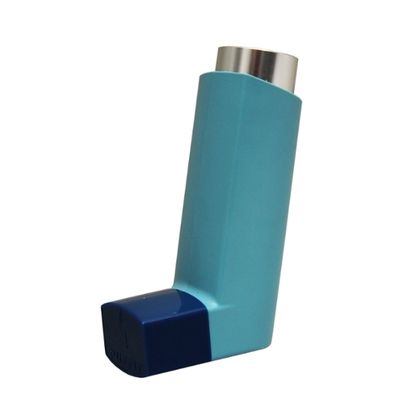The Ventolin inhaler is a reason I am not dead.
Ventolin is a reliever medication for asthma delivered in a Metered Dose Inhaler or MDI, and globally it is one of the most commonly used treatments for any medical condition. I am not dependent on it as I used to be, as I now take a new generation MDI combining reliever and preventer asthma medications, but Ventolin is a useful backup. Asthma can be fatal and I personally know of several people who have died of attacks. Hence the ongoing international drive for more effective medications.
What is asthma? It can be a wheezy or shallow fast breath though constricted airways in the lungs. The tubes have reacted to some trigger by tightening and producing mucus, leaving less room for the passage of air.
The causes of asthma are numerous and person-specific, from allergens to a change in atmospheric pressure. It can become a battle to breathe, with the out-breath often harder to perform than the in-breath. The whole body can be hunched over concentrating on the effort to get the lungs and their extensive network of tiny inflamed tubes to inflate and deflate and send that essential life force of oxygen around the body to the organs, particularly the heart and brain. Some people experience this bronchospasm as if painful metal bands are encircling the lungs. A puff or two of Ventolin can ease that crisis, even if temporarily, by soothing and relaxing the breathing muscles.
The Ventolin inhaler package consists of a metal canister, a metering valve, a mouthpiece and cap. Some people, particularly children, who find it difficult to manage a synchronised puff/in-breath, use a bulbous plastic spacer to take in the metered formulation. Ventolin contains a chemical formulation called salbutamol (in most of the world) or albuterol (in the US) which is used to relieve the bronchospasm which is the indicator of the asthma attack. When the canister is pressed into the valve, the drug is propelled by liquefied gas into the airways of the lungs which are then forced open.
The Ventolin inhaler went on the international market in 1969, but, as with most inventions, was built on existing technology. It was probably a joint effort by a team, whereby young poorly-paid technicians did much of the work. Hopefully it went through ethically robust research trials, but I suspect there were some animals and suffering in there too.
Before Ventolin, I used an earlier-version MDI which wasn’t as effective and required more inhalations, which caused heart palpitations. My teenage friends also liked to try it to experience the effect of a pounding heart.
Wikipedia names various men who developed the idea of inhalation for lung conditions. One English doctor developed an inhalation jug in the 1770s, which, a hundred years later, had evolved into a ceramic pot inhaler. French inventors developed atomisers or nebulisers from mechanisms used to dispense perfume. My first inhaler, a 1955 invention, drew from these traditions with the addition of pressure. Although the names of men are attributed to the inventions I suspect they had wives or assistants who knew how to calm wheezy children, and who provided practical input.
The tricky bit was inventing a device which was sufficiently calibrated to deliver an accurate dose for asthmatics of any age anywhere in the world. Adding the propellant chlorofluorocarbon (CFC) to the pressurised canister was the secret. Two decades after Ventolin’s invention an unexpected negative consequence of that gas ‒ atmospheric ozone depletion ‒ made buyers and prescribers wary.
New devices powered by breath alone were produced, but they were not as efficient. In New Zealand, Pharmac funded a generic without CFC but many chose to pay extra for the Ventolin, while the less effective device led to accusations of inequity for poorer asthmatics. Eventually Ventolin developed a CFC free propellant (HFA134a, also known as norflurane) on which Pharmac still imposes a part-charge. Blue inhalers including generics (cheaper versions made in other countries) are all commonly called Ventolin, although official brand names vary.
I have a friend whose son was a participant in the trial for a CFC alternative in the 1990s, illustrating the internationality of Ventolin.
Another New Zealand link to Ventolin involves its parent company: GlaxoSmithKline. Early last century Joseph Nathan’s dairy company in Bunnythorpe in the Manawatu developed a fortified milk powder for babies which he called Defiance. Truby King, that notable eugenicist and the founder of Plunket, promoted the powder for "building bonny babies".
But Nathan’s international business colleagues were wary of feeding babies ‘defiance’ so renamed it Glaxo. GlaxoSmithKline is now the second biggest international drug company. GSK is not just known for Ventolin – in 1963 they also invented Betnovate, a commonly used ointment for eczema. That is another story.
Most posts on this Access blog have tended to concentrate on the social model of disability whereby disability can be considered as a social, economic and political construction which creates barriers to full participation in society for people with impairments. But this post shows that there is also a place for technology, and it can even keep you alive.

